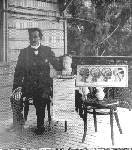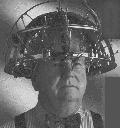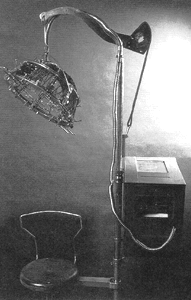


 Phrenology
was introduced as a supposedly scientific medical discipline by the Austrian physicist Franz Joseph Gall, but its easy application by
self-taught experts quickly led to its use by quacks for commercial exploitation of gullible persons, very much
like astrology, palm-reading, tarot and similar esoteric approaches. "Phrenological Parlours" sprouted
throughout Europe and the USA in the popular heyday of this movement, between 1820 and 1842. People used the advice
of phrenologists for everything, including for hiring employees, for selecting a partner for marriage and for diagnosing
mental illness or the origin of psychological afflictions.
Phrenology
was introduced as a supposedly scientific medical discipline by the Austrian physicist Franz Joseph Gall, but its easy application by
self-taught experts quickly led to its use by quacks for commercial exploitation of gullible persons, very much
like astrology, palm-reading, tarot and similar esoteric approaches. "Phrenological Parlours" sprouted
throughout Europe and the USA in the popular heyday of this movement, between 1820 and 1842. People used the advice
of phrenologists for everything, including for hiring employees, for selecting a partner for marriage and for diagnosing
mental illness or the origin of psychological afflictions.

Itinerant phrenologists were also common in these days. They would roam the hinterland carrying a portable board or a bust with the maps devised by Gall and his followers, and would talk on the marvels of phrenology to an assembly of credulous on-lookers. Afterwards, he would diagnose and advise those who ventured forward and were willing to pay his modest fees.
More scientifically-oriented characterologists, craniologists and physiognomists were, of course, incensed with the quackery and disrepute associated with phrenology. For example, one of the mainstays of the American psychology, Herbert Spencer (1820-1903), was a phrenological adept when young, and invented a new apparatus to improve the measurement of cranial features, which he named cephalometer. He subsequently abandoned phrenology as unscientific. f
But nothing could be done against it, and eventually phrenology found its way
to the dustbin of medical history.


The Phrenology Machine is a good example of how technology can be blind to the real scientific value of some diagnostic procedures, and give it an aura of respectability.
This machine was developed in order to automate the steps of a phrenological diagnosis. The patient would sit in a chair, and a metal helmet would be lowered onto the top of his head. Inside the helmet, there were several sensing rods, connected to small switches, which would tap on the skull's bulges and measure them. The information relayed by the rod's switches would then be translated to commands for a printer that had 160 different statements on a rubber belt. These were used to compose a printed report on the patient's personality.
The Phrenology Machine is well preserved in the Museum of Questionable Medical Devices, in Minneapolis,
USA, which was founded by Robert McCoy, a professional skeptic, who has collected 150 examples of medical devices
that do absolutely nothing (or once were thought to do !). The machine is still in working condition.
From: "Phrenology,
the History of Brain Localization"
By: Renato M.E. Sabbatini, PhD
In: Brain & Mind,
March 1997.